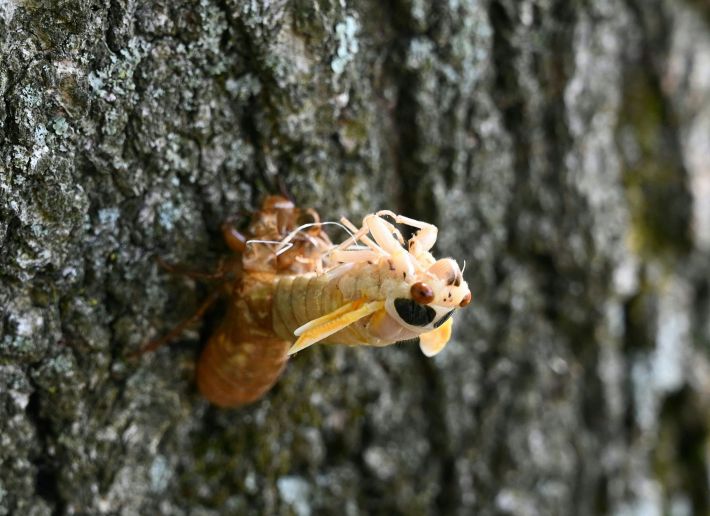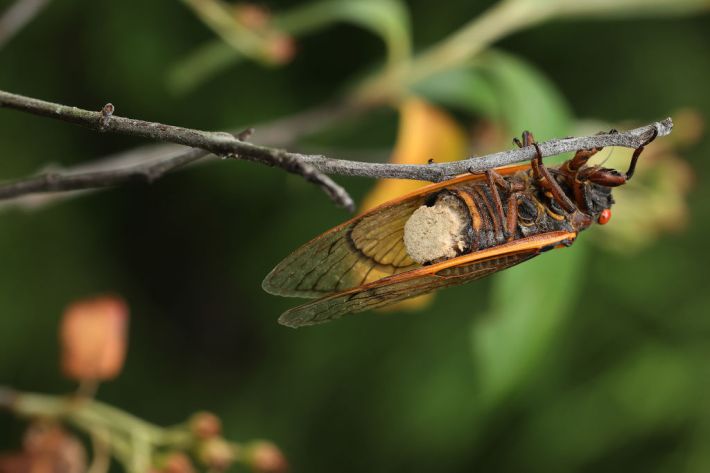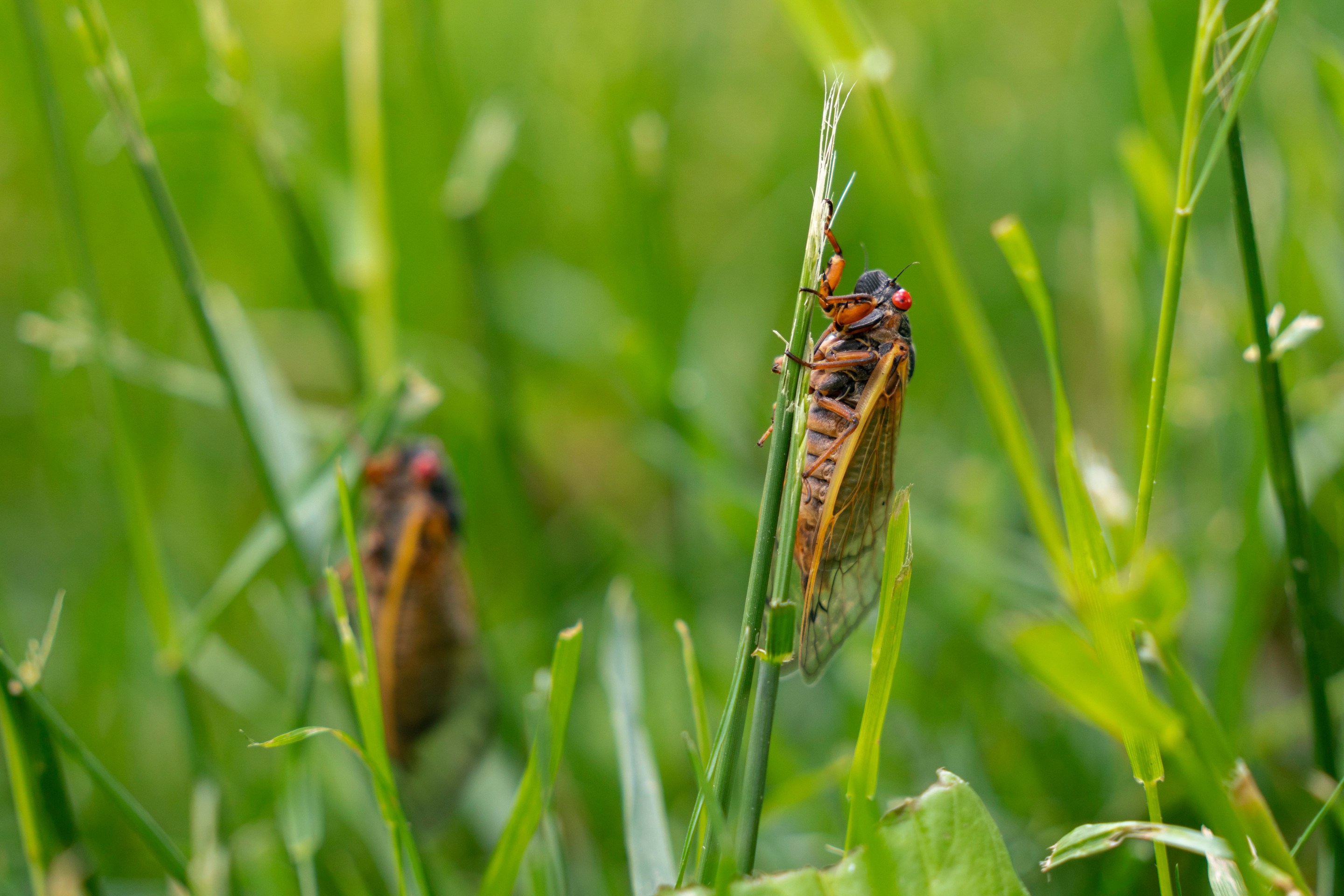Cicadas are having a moment, and for good reason—a trillion of them have begun to emerge across the southeastern and midwestern United States, along with the regular annual cicadas that get little of the fanfare of their periodical cousins. This year is particularly historic because two broods—Brood XIII, which last emerged 17 years, and Brood XIX, which last emerged 13 years ago—will briefly coincide in a sliver of central Illinois. The last time these two broods emerged was in 1803, a year when the Haitian revolutionary Toussaint Louverture died (RIP), Ohio became a state (go Buckeyes!), and scientists discovered rhodium and palladium (give it up for Rh and Pd!). Brood XIII and XIX will not meet again for another 221 years, and it is my sincere hope that they are born into a world that actually has its shit together.
Such a momentous occasion has spawned many cicada questions (can you eat them?) cicada fears (what about the zombie fungus?) and cicada slander (why are cicadas so dumb?). If you find yourself in need of some cicada answers, I have compiled an extensive FAQ on everything you could possibly need to know about the big old bugs as they crackle out of the ground in the coming weeks and join each other in a chorus of screams.
Cicada 101. What is the difference between a periodical cicada and a regular old Joe Sixpack cicada?
Cicadas are insects closely related to aphids, spittlebugs, and planthoppers like the spotted lanternfly. There are more than 3,000 species of cicadas, about 150 of which live in the United States. All cicada species have the same kind of life cycle: egg, a mushy white juvenile called a nymph, and winged adult. After nymphs hatch, they dig into the ground and drink xylem sap, which is the watery liquid traveling from a tree's roots to its leaves. Most cicadas are annual cicadas, also called dog-day cicadas. These chunky greenish-black bugs with green wing veins live for about two to nine years. But annual cicadas do not synchronize their emergence—some amount emerge each year, so it's trickier to track their exact lifespan and timing. As such, they have none of the showmanship of their more theatrical periodical counterparts and thus are shut out of the biggest cicada media frenzies.
Periodical cicadas, on the other hand, are uniquely predictable. There are 15 brood cycles that emerge either every 13 years or every 17 years, where adults all come out at once in a cacophony of vibrating sounds and seek out mates before they die. Each brood consists of up a handful of the seven species of periodical cicadas that live in the U.S. This year, all seven will be emerging in a remarkable reunion tour. The species can be most easily distinguished by their unique songs. Some sound like electric carving knives, others sound like rasps, and others "whistle-drone like B-movie spaceships," according to Science News. Periodical cicadas are slightly smaller than annuals and special because they have black bodies and bright, candy-red eyes! (づ 🔴‿🔴 )づ

Brood XII this ... Brood XIX that ... why are cicada broods named like Roman emperors?
The entomologist Charles Lester Marlatt, who was born in Kansas in 1863 and knew his way around a mustache, was the first to propose grouping periodic cicadas into 30 different broods, each distinguished by a Roman numeral. Scientists would later discover only 15 distinct broods, not 30, but Marlatt's sorting system remains. As such, the cicada broods are also pronounced like Roman emperors; for example, Brood X is "brood ten" not "brood x," even though the latter sounds way cooler. Since Marlatt's day, some cicada broods have already become extinct: Brood XXI disappeared from north Florida and Georgia, Brood XI vanished in northeast Connecticut, and Brood VII has all but disappeared in its former range in upstate New York, according to a story in The Conversation. The more exciting thing about periodical cicada names, in my opinion, is their genus name: Magicicada. It's a fitting name for a bug with a lifestyle that seems like utter magic.
Why on earth would they need to be underground for 13 or 17 years when annual cicadas grow full-size in a fraction of that time?
Although it might seem like periodical cicada nymphs spend years underground merely twiddling their equivalent of thumbs (tarsal claws) they are actually booked and busy—digging tunnels in the soil and feeding on xylem sap. Staying subterranean is also a great strategy to avoid getting eaten, which might be the primary reason a cicada's adolescence is more underground than the most alternative hipster. But scientists have some other theories about how the behavior evolved; for example, perhaps the glaciers that once covered cicada's ranges made it advantageous to time their emergence around glacial cycles.
It's also a numbers game. When they do pop up in immense hordes after 13 or 17 years, there are simply so many cicadas that predators like birds, reptiles, mammals, amphibians, and fish cannot eat them all. The sheer number of cicadas literally transforms the insects' environment, bumping up the populations of the birds and rodents that prey on them and sparing the juiciest caterpillars from imminent doom, as Benji Jones explains in Vox. There can be more than a million cicadas in a single acre of land. So even if every predator in the area stuffs themselves full, there will still be more cicadas to mate and lay their eggs, ensuring the survival of the next generation. Besides, Laura Ingalls Wilder published her first book when she was 65 years old, and Grandma Moses only started painting in earnest when she was 78. Truly great things take time!
How do they all know to come out at the same time?
A cicada brood's timing is the envy of anyone who has ever filled out a When2Meet. The broods bide their time until the soil warms up to about 64 degrees Fahrenheit, at which point they crawl out of the soil and up to the surface. So a single cicada brood will emerge at slightly different times across their geographical range, depending on when their own habitat reaches that temperature.
The larger question, of how cicadas know when 13 or 17 years has passed, puzzled scientists for a long time. As Meghan Bartels explains in Scientific American, the cicadas can mark the passage of time from the xylem they drink. When a tree blooms in spring, its xylem experiences a surge of amino acids that the cicadas track over time. Tallying 17 of these surges means tallying 17 years, allowing the cicadas to emerge exactly on time. Inevitably, some cicadas make mistakes—stragglers will occasionally emerge one or four years off from their expected timeline. Who could blame them! Not all of us are good at math.
What is the first day of an adult cicada's life like?
I'm so glad you asked. Cicadas begin emerging in the evening, and males erupt from the ground first, followed by females. The first priority of an adult cicada is to find a safe space to molt. Once they've settled somewhere, their exoskeleton will split open, revealing a pearly white adult that's still squishy to the touch. The insect must wait about half an hour for its new exoskeleton to harden. Soon they will be ready to fly around and find a tree or shrub, and hopefully a mate.

Why are they so loud! How do I make them shut up!
If you haven't seen a cicada up close, you may still have heard their droning chorus as loud as a leaf blower. Male cicadas are the only ones calling; females are quiet. While other famous insect musicians like crickets and katydids sing by rubbing their corrugated wings together, cicadas have devised their own instrument. Males have rubbery ridges on their abdomen called tymbals. When they flex their muscles, these ridges buckle, each producing a click. These muscular contractions happen between 120 to 480 times a second, which makes all these clicks sound like a continuous buzz to our ear. And these sound waves are enhanced by the insect's nearly hollow abdomens. If you pick up a cicada, you can gently raise its wing to see the tymbal, right where the wing meets the body.
Every cicada species has a distinct sound, and periodical cicadas sound louder than annual cicadas just because of their sheer numbers. The male cicadas are singing to find each other and mate on a very rapid timeline. While the orchestra of periodical cicadas might be annoying, it lasts only as long as their brief adulthood. The least you could do is let the cicadas have their day in the sun! Sure, it's possible that some sunset weddings will have unexpected musical guests drowning out their bands. But when God sings with his creations, will cicadas not be part of the choir?
One just landed on me! What does it want! I don't have any money!
That's two straight non-question questions. Please calm down. Cicadas are harmless to humans and animals. They do not have stingers. They are not venomous or poisonous. Their mouthparts are shaped like a straw to drink from roots and branches. So they cannot sting, bite, or harm us in any way aside from scaring people who do not like them. Cicadas are somewhat laughably defenseless—they have no specific predators and also no natural instinct to fly away from predators. So if one landed on you and gripped your shirt or bare skin with the itty-bitty hooks on its legs, perhaps the cicada mistook you for a tree. And really, is there a better possible compliment?
But what about the itch mites?
OK, you got me. When time cicadas emerge, the population booms are followed by a surge of oak leaf itch mites, which are nearly microscopic critters that are known to feed on cicada eggs. If you happen to be standing near a tree where cicadas are known to cavort on a windy day, a mite could land on you, entomologist Sammy Ramsey told the New York Times. And if one does, it will bite, leading to an itchy rash. But it's not like the periodical cicadas invited the mites; they can't help being extremely tasty at all stages of their life. Cicadas innocent. Totally exonerated!
Will they eat me? Can I eat them?
If your pet eats a cicada or two, they will probably be fine. But your dog should not go to chow-town on the bugs, as their shells can potentially inflame their tummies or cause a blockage, per CNET. Just monitor your pet after their cicada snacks to make sure they seem OK.
Humans can also eat cicadas. The chef Bun Lai described their flavor as sweet and bitter, recalling walnuts, chestnuts, and adzuki beans and their crunchy-creamy texture like soft-shell crab—they are arthropods after all. You can put them in soup, in kimchi, in tempura, in Spanish tortillas, in casseroles, in stir fry tossed with some Old Bay. Some chefs recommend harvesting them at their most tender—just as they have just begun to molt and blanching them in boiling water for one minute. This way, they reportedly taste like cold, canned asparagus. For an entry-level cicada dish, one entomologist recommends dipping them in chocolate—"like eating a chocolate-covered pecan."
But what about my trees, my precious trees! Are the cicadas a big a menace to plant life as a plague of locusts, as mentioned in canonical texts including the Bible, the Quran, and the 1978 film Days of Heaven, which was great despite being narrated by a child actor playing a child from Texas with the thickest New York accent I've ever heard?
Cicadas won't eat your plants, but they can damage young trees—not by eating them, but by laying their eggs. After mating, female cicadas lay their eggs in by cutting slits into tree branches. When the eggs hatch six to seven weeks later, the mushy white nymphs fall to the ground like maggoty rain and dig into the soil to feed, molt, and grow. Mature trees have no problem weathering this intrusion, but trees and shrubs younger than three years old might experience some damage. It's not recommended to plant any new trees or shrubs during periodical cicada season, but if you do already have some saplings, you can protect them by wrapping them in tulle or an insect netting. This keeps the cicadas out but still allows the tree to drink in light. (The Morton Arboretum has a nice guide.)
And what about this deadly cicada zombie fungus I'm hearing about? That seems like bad news!
Ah, the fungus that is transforming cicadas into "sex-crazed zombies" and "flying saltshakers of death" per CNN? Good news for headline writers, but certainly bad news for the cicadas. The fungus is called Massospora cicadina. While it's not yet known how the insects are exposed to its spores, the fungal spores will penetrate the cicadas' bodies and build up a mass in their abdomen. And then the horrors begin: The cicada's rear and genitals fall off, exposing a chalky plug. Then the infested cicada, despite having nearly a third of its body replaced by a fungus, goes about its day as if everything were normal—trying to mate, flying around, climbing trees, etc. It must be pretty disgusting to see your abdomen and genitals lopped off and replaced with a "plug of yellow spores." (Although it is a fate I would probably still wish on my true enemies.)
But this fungus also has another effect; it's got cicadas down bad. "There's this hyper-sexualized behavior," Matthew Kasson, a mycologist and forest pathologist at West Virginia University, told CNN. "So, males for example, they'll continue to try and mate with females — unsuccessfully, because again, their back end is a fungus." Both Brood XIII and Brood XIX are susceptible to the fungus, and Kasson is collecting infected cicadas, especially from Brood XIX. He asks that people upload observations of any zombified cicadas to iNaturalist. There is no pay for this labor, but is there anything sweeter than the joy of beholding a red-eyed horny husk of spores? Literally, name anything sweeter than that!

...can I eat a fungus-infested cicada? Seriously what's the worst thing that could happen?
Honestly, probably nothing. M. cicadina can only infect cicadas, and only the 13- and 17-year periodicals at that, so it will not turn you into a zombie. And though the fungal plugs are full of amphetamines, the dose would be so small that we would not be affected. In fact, these fungus-infected cicadas might be just as tasty in a stir fry as their boring, non-infested counterparts. I swear I give these statements freely, under no outside influence, and if you see me in person, you would certainly NOT find any chalky fungus plug anywhere near my person.
When will they go away?
Adult cicadas live for just about a month, and both broods will likely be gone by mid-July. But they will have laid their eggs, which will hatch in six to 10 weeks, erupting into baby nymphs that will wriggle their way in the soil and begin to sup on sap for the following 13 or 17 years. In this light, periodical cicadas never go away. They are always around in some form—egg, nymph, winged adult, chocolate-covered confection. So whenever you sit under a tree east of the Mississippi River, remember that the periodical cicadas never left. They are there with you in the billions, soft and hungry, just a few feet below.






